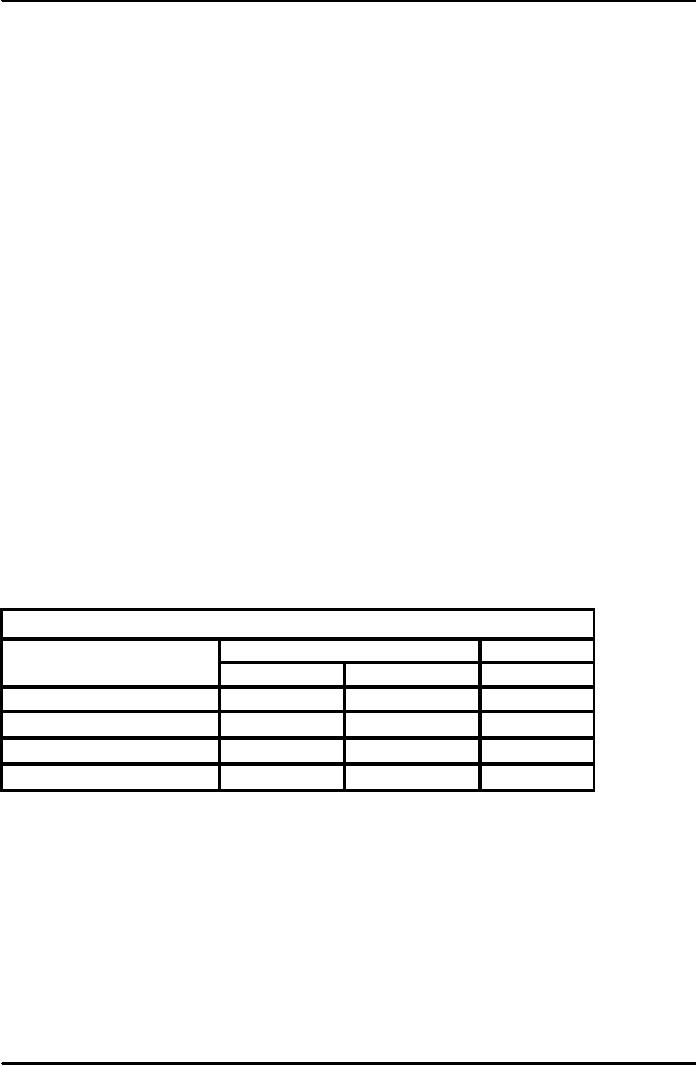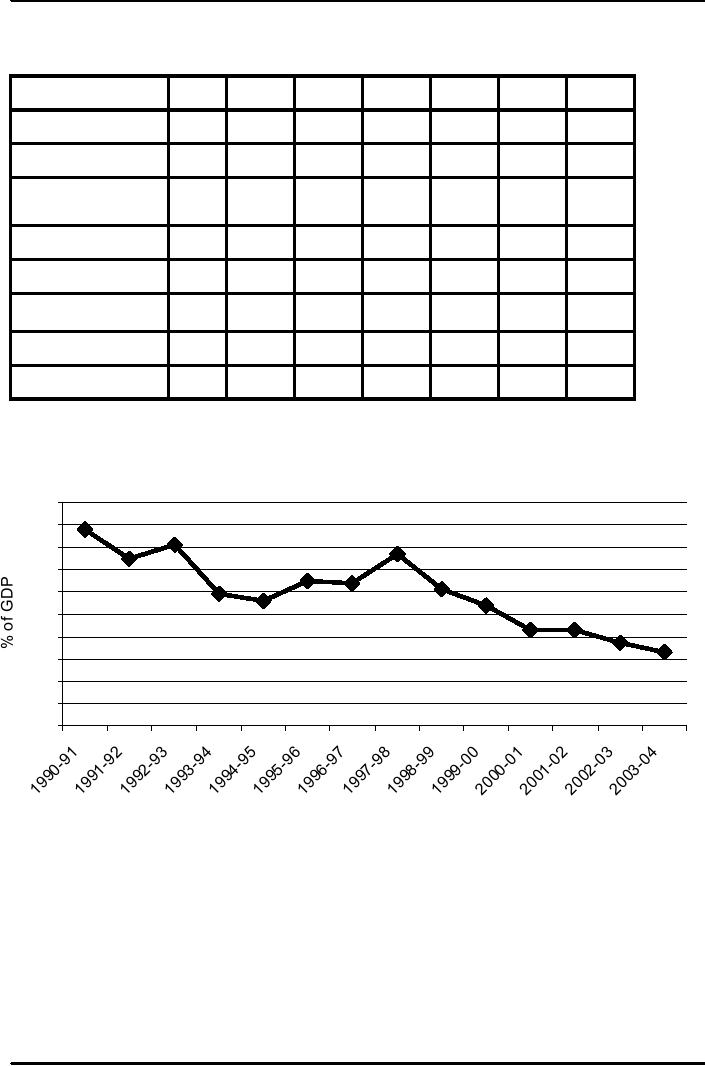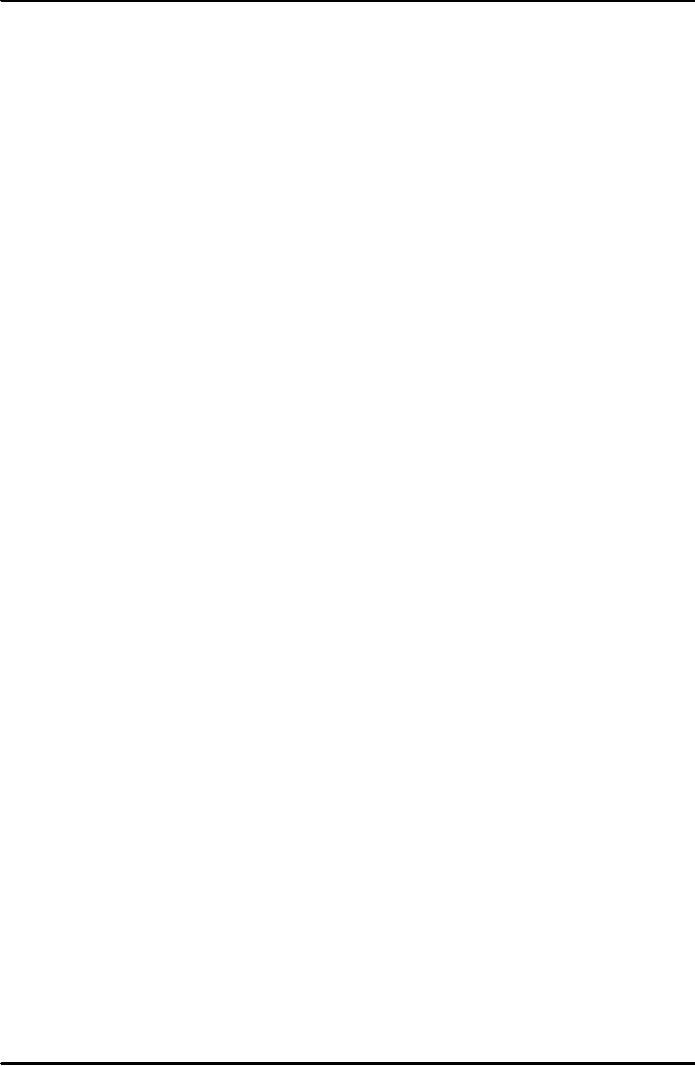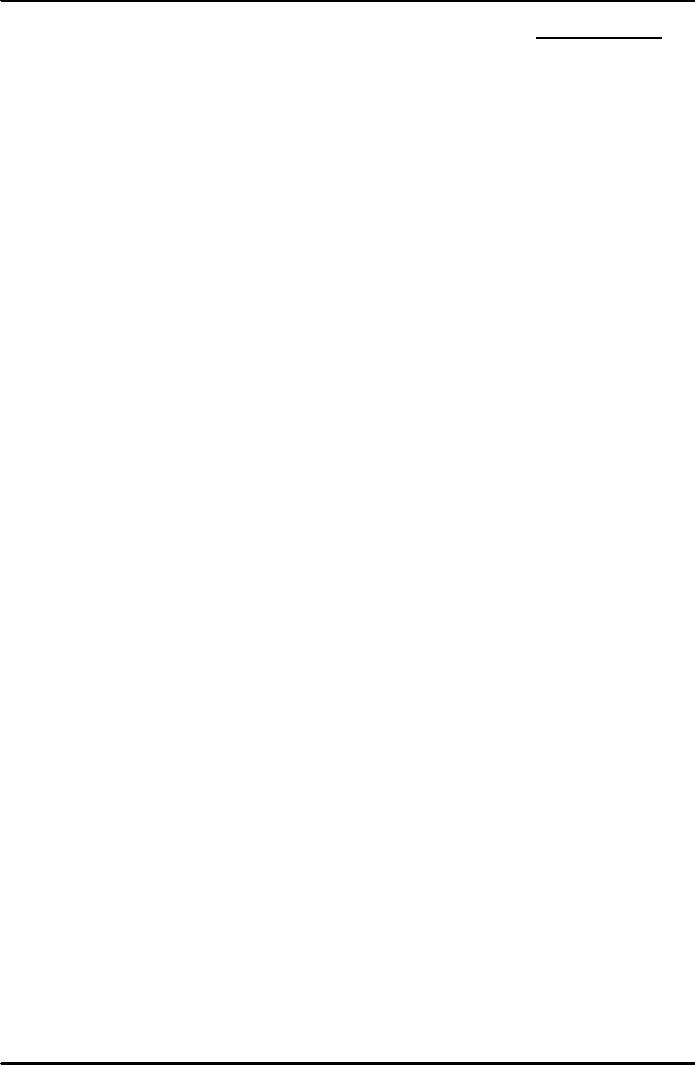 |
GOVERNMENT DEBT:Permanent Debt, Floating Debt, Unfunded Debts |
| << AGGREGATE SUPPLY (Continued…):Deriving the Phillips Curve from SRAS |
| GOVERNMENT DEBT (Continued…):Starting with too little capital, >> |

Macroeconomics
ECO 403
VU
LESSON
35
GOVERNMENT
DEBT
Government
debt and the annual
budget deficit
·
When a
government spends more than
it collects in taxes, it borrows
from the private
sector
to finance the budget
deficit.
·
The
government
debt is an
accumulation of all past
annual deficits.
Components
of Domestic Debt
·
Permanent
Debt
Market
Loans
Federal
Government Bonds
Income
tax Bonds
National
Funds Bonds
Federal
investment Bonds
Prize
Bonds
·
Floating
Debt
Treasury
Bills
Market
Treasury Bills
·
Unfunded
Debts
Savings or
Deposit Certificates
Savings
Account
Postal
Life insurance
GP
Fund
Domestic
Debt Outstanding
million
rupees
STOCK
Flow
up to
30-Jun-04
31-Jan-05
31-Jan-05
A:Permanent
Debt
536,800
512,956
(23,844)
B:Floating
Debt
542,943
611,648
68,704
C:Unfunded
Debt
899,215
890,474
(8,741)
Total
(A + B + C)
1,978,958
2,015,078
36,120
163

Macroeconomics
ECO 403
VU
Trends
in Public Debt
Rs.
Billions
End
June
1990
1995
2000
2001
2002
2003
2004
Debt
payable in Rs
373.6
789.7
1575.9
1728.0
1715.2
1853.7
1921.4
%
of GDP 42.8
42.3
41.5
41.5
39.1
38.4
35.2
Debt
payable in
427.6
872.5
1670.4
2025.8
1984.1
1891.3
1927.1
Forex
%
of GDP 48.9
46.8
44.0
48.6
45.1
39.2
35.3
Total
Public Debt
801.2
1662.2
3246.4
3753.8
3699.3
3745.0
3848.5
Grants
33.4
40.5
83.1
114.2
42.6
Net
Public Debt
801.2
1662.2
3213.0
3713.3
3616.2
3630.8
3805.9
%
of GDP 91.7
89.1
84.7
89.2
82.2
75.3
69.7
Source:
Debt office, Ministry of
Finance
Budget
Deficit of Pakistan
(as
percentage of GDP)
10
9
8
7
6
5
4
3
2
1
0
Problems
in Measurement
Govt.
Budget Deficit = Govt.
Spending Govt.
Revenue
=
Amount of new debt
·
A
meaningful deficit...
Modifies
the real value of
outstanding public debt to
reflect current
inflation.
Subtracts
govt. assets from govt.
debt.
Includes
hidden liabilities that
currently escape detection in
the accounting
system.
Calculates a
cyclically-adjusted budget
deficit
164

Macroeconomics
ECO 403
VU
Inflation
·
Almost
all economists agree that
the government's indebtness
should be measured in
real
terms,
not in nominal terms. The
measured deficit should
equal the change in
the
government's
real debt, not the
change in its nominal
debt
·
However,
the commonly measured budget
deficit does not correct
for inflation
·
An
example
Suppose the
real government debt is not
changing. In other words, in
real terms, the
budget
is balanced
In this case,
the nominal debt must be
rising at the rate of
inflation. i.e.
ΔD / D = š
Where
š
is
the inflation rate and D is
the stock of government
debt
This
implies
ΔD = š
D
·
So
by looking at the change in
nominal debt ΔD, a budget
deficit of šD can be
reported
·
Hence
most economists believe that
the reported budget deficit
is overstated by the
amount
šD
·
Another
perspective
Govt.
budget deficit = govt.
Expenditure Govt.
Revenues
For
correct measurement of budget
deficit, the government
expenditure should
include
only
the real interest paid on
the debt (rD), not
the nominal interest paid
(iD)
Since
ir=š
Budget
deficit is overstated by šD
·
Example:
In
1979
Budget
deficit = $28
billions
š
=
8.6 %
Government
debt = $495 billion
Budget
Deficit overstated, šD = 0.086 x
495
=
$43 billion
So,
$28
- $43= $ 15 billion
surplus
Capital
Assets
·
An
accurate assessment of government's
budget deficit requires
accounting for the
govt.'s
assets
as well as liabilities
·
Particularly,
when measuring govt.'s
overall indebtness, we should
subtract government
assets
from government debt.
So
Govt.
budget deficit = change in
debt change in
assets
·
Individuals
and firms treat assets
and liabilities
symmetrically
·
Borrowing
to buy a house does not
amount to budget deficit,
because the increase
in
assets
(house) is offset by increase in
debt (lease rent) and
thus, no change in net
wealth
165

Macroeconomics
ECO 403
VU
·
A
budget procedure that
accounts for assets as well
liabilities is called capital
budgeting,
because
it takes into account the
changes in capital.
·
For
Example
The
government sells some of its
land or buildings and uses
the proceeds to reduce
the
budget
deficit
·
Under current
budget procedure, the
reported deficit would be
lower
·
Under capital
budgeting, reduction in debt
would be offset by a reduction in
assets
Similarly,
government borrowings to finance
purchase of capital assets
would not raise
budget
deficit
·
Problem
with capital
Budgeting
It is hard to
decide which government
expenditures should count as
capital
expenditures.
Uncounted
Liabilities
·
Measuring
budget deficit may be
misleading because it excludes
some govt.
liabilities.
Pension of
Govt. workers
Social security
system
·
Although
social security liabilities
can be differentiated from
government debt, yet
the
government
can always choose not to
repay all of its
debt.
The
Business Cycle
·
Changes
occur automatically in response to a
fluctuating economy.
·
Example:
Recession
Incomes
⇒ Personal
Taxes
Profits
⇒ Corporate
Taxes
Number of
needy persons ⇒
G
Budget
Deficit Increases
·
These
automatic changes are not
errors in measurement since
government truly borrows
in
such
situations.
·
But
this makes it difficult to
use deficit to monitor
changes in fiscal policy.
i.e the deficit
can
either
fall or rise either
because
Government
has changed its policy
or
Economy
has changed direction
·
Cyclically
adjusted (full employment)
budget deficit reflects
policy changes but not
the
current
stage of the business
cycle
166
Table of Contents:
- INTRODUCTION:COURSE DESCRIPTION, TEN PRINCIPLES OF ECONOMICS
- PRINCIPLE OF MACROECONOMICS:People Face Tradeoffs
- IMPORTANCE OF MACROECONOMICS:Interest rates and rental payments
- THE DATA OF MACROECONOMICS:Rules for computing GDP
- THE DATA OF MACROECONOMICS (Continued…):Components of Expenditures
- THE DATA OF MACROECONOMICS (Continued…):How to construct the CPI
- NATIONAL INCOME: WHERE IT COMES FROM AND WHERE IT GOES
- NATIONAL INCOME: WHERE IT COMES FROM AND WHERE IT GOES (Continued…)
- NATIONAL INCOME: WHERE IT COMES FROM AND WHERE IT GOES (Continued…)
- NATIONAL INCOME: WHERE IT COMES FROM AND WHERE IT GOES (Continued…)
- MONEY AND INFLATION:The Quantity Equation, Inflation and interest rates
- MONEY AND INFLATION (Continued…):Money demand and the nominal interest rate
- MONEY AND INFLATION (Continued…):Costs of expected inflation:
- MONEY AND INFLATION (Continued…):The Classical Dichotomy
- OPEN ECONOMY:Three experiments, The nominal exchange rate
- OPEN ECONOMY (Continued…):The Determinants of the Nominal Exchange Rate
- OPEN ECONOMY (Continued…):A first model of the natural rate
- ISSUES IN UNEMPLOYMENT:Public Policy and Job Search
- ECONOMIC GROWTH:THE SOLOW MODEL, Saving and investment
- ECONOMIC GROWTH (Continued…):The Steady State
- ECONOMIC GROWTH (Continued…):The Golden Rule Capital Stock
- ECONOMIC GROWTH (Continued…):The Golden Rule, Policies to promote growth
- ECONOMIC GROWTH (Continued…):Possible problems with industrial policy
- AGGREGATE DEMAND AND AGGREGATE SUPPLY:When prices are sticky
- AGGREGATE DEMAND AND AGGREGATE SUPPLY (Continued…):
- AGGREGATE DEMAND AND AGGREGATE SUPPLY (Continued…):
- AGGREGATE DEMAND AND AGGREGATE SUPPLY (Continued…)
- AGGREGATE DEMAND AND AGGREGATE SUPPLY (Continued…)
- AGGREGATE DEMAND AND AGGREGATE SUPPLY (Continued…)
- AGGREGATE DEMAND IN THE OPEN ECONOMY:Lessons about fiscal policy
- AGGREGATE DEMAND IN THE OPEN ECONOMY(Continued…):Fixed exchange rates
- AGGREGATE DEMAND IN THE OPEN ECONOMY (Continued…):Why income might not rise
- AGGREGATE SUPPLY:The sticky-price model
- AGGREGATE SUPPLY (Continued…):Deriving the Phillips Curve from SRAS
- GOVERNMENT DEBT:Permanent Debt, Floating Debt, Unfunded Debts
- GOVERNMENT DEBT (Continued…):Starting with too little capital,
- CONSUMPTION:Secular Stagnation and Simon Kuznets
- CONSUMPTION (Continued…):Consumer Preferences, Constraints on Borrowings
- CONSUMPTION (Continued…):The Life-cycle Consumption Function
- INVESTMENT:The Rental Price of Capital, The Cost of Capital
- INVESTMENT (Continued…):The Determinants of Investment
- INVESTMENT (Continued…):Financing Constraints, Residential Investment
- INVESTMENT (Continued…):Inventories and the Real Interest Rate
- MONEY:Money Supply, Fractional Reserve Banking,
- MONEY (Continued…):Three Instruments of Money Supply, Money Demand